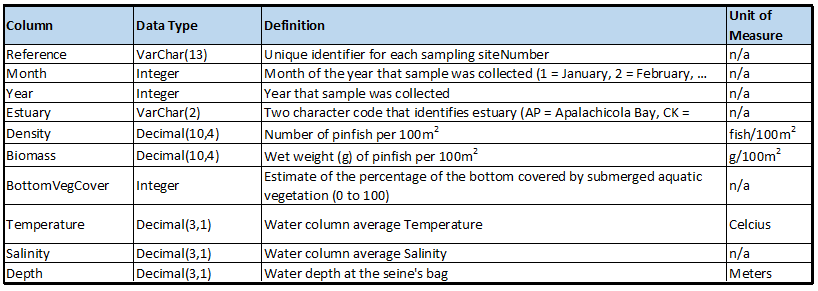Copy this text
Pinfish Database: The Florida Fisheries-Independent Monitoring (FIM) programs Pinfish data from Eastern Gulf of Mexico estuaries
Sound management is necessary to preserve the health of Florida's marine environments for our present and future enjoyment. Florida's Fisheries-Independent Monitoring program (FIM) informs mangers on abundance trends of fisheries resources in Florida waters. Stratified-random sampling in estuarine habitats has been conducted since 1989 with the goals of estimating nekton abundance and describing population trends in estuarine regions throughout Florida. Three gear types are deployed: 183-m haul seine with 37.5-mm stretch mesh, 21.3-m center-bag seine with 3.1-mm delta mesh, and 6.1-m otter trawl with 37.5-mm stretch mesh and a 3.1-mm delta mesh liner in the bag. All species of nekton (crabs, shrimp, and fish) collected are identified to the lowest practical taxonomic level, enumerated, and a representative subsample of lengths are measured. Location (latitude, longitude, depth), weather (wind direction/speed, tide), date/time, habitat characterizations (bottom substrate, submerged aquatic vegetation, shore type) and water quality parameters (temperature, conductivity, salinity, pH, dissolved oxygen) are recorded at each sampling site. Sampling is conducted with a monthly periodicity during daylight hours (one hour after sunrise to one hour before sunset).
Database Contents: This is a subset of the Florida FIM program data (1998 - 2016) used to assess population trends, estimate growth, and describe habitat use of Lagodon rhomboides (Pinfish) in four Gulf of Mexico estuaries (Apalachicola Bay, Cedar Key, Tampa Bay, and Charlotte Harbor. Data include abundance (animals/100m2), biomass (grams/100m2), and Standard-Length measurements (millimeters) of Pinfish with associated habitat (Bottom Vegetation Percent Cover, Salinity), water quality (Temperature, Salinity, Depth) and temporal (Year, Month) variables.
Methods: Pinfish were collected each month between 1998 and 2016 using a 21.3-m center bag seine with 3.2-mm mesh in Apalachicola Bay, Cedar Key, Tampa Bay, and Charlotte Harbor. A stratified-random sampling design was used to select sites to be sampled each month. Water quality measurements (temperature, salinity, conductivity, pH, and dissolved oxygen) were recorded with either a Hydrolab© or YSI© water quality sonde at each sampling site. Habitat characterizations were also recorded for each site. The seine was deployed in a consistent manner, with an estimated 140m2 of bottom area sampled by each net haul. All Pinfish were identified, counted, and a representative subsample were measured for Standard Length (mm).
Disciplines
Biological oceanography
Keywords
Pinfish, Stratified-Random Sampling, Florida, Estuaries, Fisheries-Independent Monitoring, Abundance, Growth, Habitat Association
Location
31N, 26S, -82E, -87W
Devices
Abundance Data

Length data


